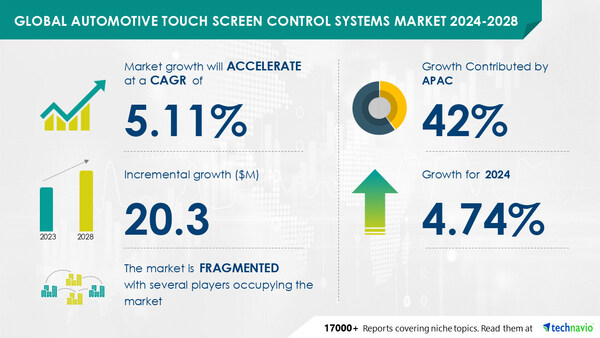NEW YORK, Sept. 18, 2024 /PRNewswire/ — Report with the AI impact on market trends- The global automotive touch screen control systems market size is estimated to grow by 20.3 million from 2024-2028, according to Technavio. The market is estimated to grow at a CAGR of almost 5.11% during the forecast period. Growing uptake of electronics in automobiles is driving market growth, with a trend towards emergence of large-screen display systems. However, slowdown in automobile sales worldwide poses a challenge. Key market players include Analog Devices Inc., Continental AG, Dawar Technologies, Fujitsu Ltd., Infineon Technologies AG, Kyocera Corp., Lascar electronics Ltd., LEONHARD KURZ Stiftung and Co. KG, Methode Electronics Inc., Microchip Technology Inc., Orient Display USA Corp., Robert Bosch GmbH, Samsung Electronics Co. Ltd., Semtech Corp., STAFL Systems LLC, STMicroelectronics International N.V., Synaptics Inc., Texas Instruments Inc., TouchNetix Ltd., and US Micro Products Inc..
AI-Powered Market Evolution Insights. Our comprehensive market report ready with the latest trends, growth opportunities, and strategic analysis- View your snapshot now
|
Forecast period |
2024-2028 |
|
Base Year |
2023 |
|
Historic Data |
2018 – 2022 |
|
Segment Covered |
Application (Resistive and Capacitive), Vehicle Type (Passenger cars and Commercial vehicles), and Geography (APAC, Europe, North America, South America, and Middle East and Africa) |
|
Region Covered |
APAC, Europe, North America, South America, and Middle East and Africa |
|
Key companies profiled |
Analog Devices Inc., Continental AG, Dawar Technologies, Fujitsu Ltd., Infineon Technologies AG, Kyocera Corp., Lascar electronics Ltd., LEONHARD KURZ Stiftung and Co. KG, Methode Electronics Inc., Microchip Technology Inc., Orient Display USA Corp., Robert Bosch GmbH, Samsung Electronics Co. Ltd., Semtech Corp., STAFL Systems LLC, STMicroelectronics International N.V., Synaptics Inc., Texas Instruments Inc., TouchNetix Ltd., and US Micro Products Inc. |
Key Market Trends Fueling Growth
The global automotive touch screen control systems market is experiencing significant growth due to the trend of larger in-vehicle touch screen displays. In the early 2000s, most vehicles featured analog instrument clusters and small binary displays for music systems. However, advancements in display technology, the increasing penetration of automotive electronics, and fierce competition in the automotive industry have led to the widespread adoption of digital displays in automotive instrument clusters and infotainment systems. Modern vehicles are now offering full touchscreen systems, and the size of these displays has increased substantially in recent years. For instance, some automakers are integrating the HVAC system display and infotainment display system into a single, large unit. This trend is important for automotive OEMs as a product differentiator, allowing them to modernize vehicles with large infotainment screens. Notable examples include Tesla’s use of a single, large portrait touchscreen display in all its vehicles, and the recent launches of the Mahindra XUV400 Pro in India with a 10.25-inch touchscreen and instruments display, and facelifts for the Ford Ecosport, Hyundai Grand i10 Nios, and Tata Nexon in India, all featuring large infotainment screens. These developments will continue to drive the growth of the global automotive touch screen control systems market.
The Automotive Touch Screen Control Systems market is experiencing significant growth due to the increasing demand for advanced in-car technologies. Key trends include augmented reality and advanced graphics for enhanced driving experiences, in-car payment systems for convenience, and eco-friendly materials for sustainability. Commercial vehicles and fleet management are also adopting touch screen technology for improved cockpit efficiency. Product development teams, including engineers and designers, use user-friendly interaction interfaces, UX research, and human-machine interface approaches to create cockpits that prioritize comfort and vehicle interiors. OEMs and Tier 1 suppliers are integrating touch identification, resistive touch panels, and gesture control for a more personalized driving experience. The global automotive fleet is embracing touch screen technology for cabin premiumness and connectivity systems, including safety features, electronics, and hybrids or electrification. Large-screen display systems and digital displays are becoming standard in passenger cars, light commercial vehicles, and heavy commercial vehicles, revolutionizing the driving experience.
Insights on how AI is driving innovation, efficiency, and market growth- Request Sample!
Market Challenges
- The global automotive touch screen control systems market is significantly influenced by the automobile industry’s sales performance. The COVID-19 pandemic led to a decrease in vehicle sales worldwide, negatively impacting the market. In 2020, vehicle sales declined due to nationwide lockdowns and supply chain disruptions, primarily caused by logistical and transportation restrictions. Major automobile manufacturers in Europe and North America experienced production shutdowns, reducing the market’s revenue. China, South Korea, India, Japan, Germany, France, and Italy experienced significant declines in light vehicle sales. Despite the decline in COVID-19 cases, factors such as semiconductor shortages, Brexit, trade tensions between the US and China, tight liquidity, higher insurance and tax rates, political instability, and currency fluctuations continue to hinder automotive sales. In India, poor consumer buying behavior and the growing popularity of car-sharing models further contribute to the trend. Consequently, the decline in automotive sales acts as a significant barrier to the growth of the automotive touch screen control systems market.
- The Automotive Touch Screen Control Systems Market is experiencing significant growth due to the increasing demand for modern vehicles with advanced infotainment systems. Two main touch screen technologies, resistive and capacitive, face challenges in this market. Resistive screens, common in smaller displays below 9 inches, struggle with poor response times and low resolution. Capacitive screens, used in larger displays above 15 inches, face challenges with haptic feedback and high cost. Chassis modules, safety products, external lighting, brakes, steering parts, plastic parts, ADAS, vehicle electronics, infotainment solutions, tires, technical elastomers, and connectivity trends are integral to the automotive industry. Automakers focus on advanced automotive technologies, including driver assistance systems and touch screen displays, to meet consumer demands. Connectivity features, such as smartphone mirroring, Bluetooth, and voice recognition, are essential for both high-end and mid-range vehicles. Entry-level cars also offer touch screen displays for basic navigation, entertainment, climate control, and connectivity. However, challenges include vehicle weight reduction, environmental concerns, driver distraction, and safety concerns. Market players must innovate to address these challenges, offering high-resolution displays, advanced driver assistance systems, and lightweight touch screen control systems. The future of the Automotive Touch Screen Control Systems Market lies in the integration of touch screen technology with vehicle interior design and the development of advanced connectivity solutions.
Insights into how AI is reshaping industries and driving growth- Download a Sample Report
Segment Overview
This automotive touch screen control systems market report extensively covers market segmentation by
- Application
- 1.1 Resistive
- 1.2 Capacitive
- Vehicle Type
- 2.1 Passenger cars
- 2.2 Commercial vehicles
- Geography
- 3.1 APAC
- 3.2 Europe
- 3.3 North America
- 3.4 South America
- 3.5 Middle East and Africa
1.1 Resistive- The Automotive Touch Screen Control Systems market is experiencing significant growth due to the increasing adoption of resistive touch screens in vehicle infotainment systems. A resistive touch screen consists of two conducting layers separated by a small air gap. When a user touches the screen with a finger or a pen, the layers come into contact, causing a voltage shift. This voltage change is detected by the RTP controller, which determines the touch position. The high accuracy of resistive touch screens makes them preferred over capacitive ones in automotive applications. The precise point where the two layers meet is registered and recognized as a touch command, ensuring reliable operation. This feature is crucial in automotive touch screens, as it allows for accurate control of various vehicle functions, thereby driving the growth of the segment during the forecast period.
Download complimentary Sample Report to gain insights into AI’s impact on market dynamics, emerging trends, and future opportunities- including forecast (2024-2028) and historic data (2018 – 2022)
Research Analysis
The Automotive Touch Screen Control Systems market is experiencing significant growth, driven by the increasing demand for advanced electronics in modern vehicles. Aftermarket entertainment systems are becoming increasingly popular, offering connectivity trends such as smartphone mirroring and Bluetooth integration. Automakers are focusing on developing large-screen display systems and digital displays for navigation, entertainment, climate control, and safety features. Human-Machine Interface (HMI) is a key consideration, with user-friendly interaction interfaces becoming essential for an enjoyable driving experience. Electrification and hybrid powertrains are also driving the market, as automakers integrate touch screen control systems for battery management and charging systems. Advanced infotainment systems are becoming standard in new vehicles, offering features such as real-time traffic updates, weather information, and music streaming. Product development teams of automakers and engineers are employing design thinking approaches to create intuitive and visually appealing touch screen control systems that enhance comfort and convenience in vehicle interiors. Display technologies such as OLED and AMOLED are gaining popularity due to their high resolution and energy efficiency. Overall, the automotive touch screen control systems market is a dynamic and innovative space, continually evolving to meet the changing needs and expectations of consumers.
Market Research Overview
The Automotive Touch Screen Control Systems market encompasses advanced electronics and large-screen display systems for cars, motorization, and commercial vehicles. These systems include aftermarket entertainment systems, connectivity features, navigation, climate control, and advanced infotainment solutions. The market caters to passenger cars, light commercial vehicles, and heavy commercial vehicles, featuring resistive and capacitive touch technology, haptic feedback, and high-resolution displays. Modern vehicles integrate touch screen displays for driver assistance systems (ADAS), vehicle electronics, and safety features. Connectivity trends include smartphone mirroring via Bluetooth and voice recognition. Capacitive touch technology, high-end vehicles, and mid-range vehicles are driving the demand for advanced automotive technologies. Environmental concerns and vehicle weight reduction are key considerations, with eco-friendly materials and biometric identification gaining popularity. Commercial vehicles focus on fleet management, cockpit design, and user-friendly interaction interfaces. Product development teams employ design thinking approaches, UX research, and display technologies to enhance the driving experience, comfort, and vehicle interiors.
Table of Contents:
1 Executive Summary
2 Market Landscape
3 Market Sizing
4 Historic Market Size
5 Five Forces Analysis
6 Market Segmentation
- Application
- Resistive
- Capacitive
- Vehicle Type
- Passenger Cars
- Commercial Vehicles
- Geography
- APAC
- Europe
- North America
- South America
- Middle East And Africa
7 Customer Landscape
8 Geographic Landscape
9 Drivers, Challenges, and Trends
10 Company Landscape
11 Company Analysis
12 Appendix
About Technavio
Technavio is a leading global technology research and advisory company. Their research and analysis focuses on emerging market trends and provides actionable insights to help businesses identify market opportunities and develop effective strategies to optimize their market positions.
With over 500 specialized analysts, Technavio’s report library consists of more than 17,000 reports and counting, covering 800 technologies, spanning across 50 countries. Their client base consists of enterprises of all sizes, including more than 100 Fortune 500 companies. This growing client base relies on Technavio’s comprehensive coverage, extensive research, and actionable market insights to identify opportunities in existing and potential markets and assess their competitive positions within changing market scenarios.
Contacts
Technavio Research
Jesse Maida
Media & Marketing Executive
US: +1 844 364 1100
UK: +44 203 893 3200
Email: [email protected]
Website: www.technavio.com/
SOURCE Technavio
WANT YOUR COMPANY’S NEWS FEATURED ON PRNEWSWIRE.COM?
440k+
Newsrooms &
Influencers
9k+
Digital Media
Outlets
270k+
Journalists
Opted In



